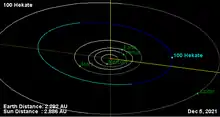 orbit | |
| Discovery | |
|---|---|
| Discovered by | J. C. Watson |
| Discovery date | 11 July 1868 |
| Designations | |
| (100) Hekate | |
| Pronunciation | /ˈhɛkətiː/[1] |
Named after | Hecate |
| 1955 QA | |
| Main belt | |
| Adjectives | Hekatean (Hecatæan) /hɛkəˈtiːən/[1] |
| Orbital characteristics[2] | |
| Epoch 31 July 2016 (JD 2457600.5) | |
| Uncertainty parameter 0 | |
| Observation arc | 144.93 yr (52936 d) |
| Aphelion | 3.61005 AU (540.056 Gm) |
| Perihelion | 2.56919 AU (384.345 Gm) |
| 3.08962 AU (462.201 Gm) | |
| Eccentricity | 0.16844 |
| 5.43 yr (1983.6 d) | |
| 64.6430° | |
| 0° 10m 53.357s / day | |
| Inclination | 6.42957° |
| 127.199° | |
| 184.736° | |
| Earth MOID | 1.55453 AU (232.554 Gm) |
| Jupiter MOID | 1.66378 AU (248.898 Gm) |
| TJupiter | 3.194 |
| Physical characteristics | |
| Dimensions | 88.66±2.0 km[2] 89 km[3] |
| Mass | ~1.0×1018 kg |
Mean density | ~2.7 g/cm3 (estimate)[4] |
Equatorial surface gravity | ~0.033 m/s2 |
Equatorial escape velocity | ~0.054 km/s |
| 27.066 h (1.1278 d)[2] 0.5555 d[5] | |
| 0.1922±0.009[2] 0.192[3] | |
| Temperature | ~154 K max: 238K (-35°C) |
| S-type asteroid | |
| 7.67 | |
Hekate (minor planet designation: 100 Hekate) is a large main-belt asteroid.
About
_Hekate.png.webp)
This is a stony S-type asteroid with a diameter of 87+5
−4 km and a sidereal rotation period of 27.07 h.[6] It orbits in the same region of space as the Hygiea asteroid family, though it is actually an unrelated interloper. However, its geometric albedo of 0.22±0.03[6] is too high, and it is of the wrong spectral class to be part of the dark carbonaceous Hygiea family. It is listed as a member of the Hecuba group of asteroids that orbit near the 2:1 mean-motion resonance with Jupiter.[7]
Hekate was the 100th asteroid to be discovered, by Canadian-American astronomer J. C. Watson (his fourth discovery) on July 11, 1868.[8] It is named after Hecate, the goddess of witchcraft in Greek mythology, but its name also commemorates it as the hundredth asteroid, as ἑκατόν (hekaton) is Greek for 'hundred'.
A Hekatean occultation of a star was observed on July 14, 2003, from New Zealand.
See also
References
- 1 2 "Hecate". Oxford English Dictionary (Online ed.). Oxford University Press. (Subscription or participating institution membership required.)
- 1 2 3 4 "100 Hekate". JPL Small-Body Database. Jet Propulsion Laboratory. SPK-ID: 2000100. Retrieved 12 May 2016.
- 1 2 "IRAS Minor Planet Survey". Archived from the original on 11 December 2005.
- ↑ Krasinsky, G. A. (2002). "Hidden Mass in the Asteroid Belt". Icarus. 158 (1): 98. Bibcode:2002Icar..158...98K. doi:10.1006/icar.2002.6837.
- ↑ "Asteroid Lightcurve Parameters".
- 1 2 Marciniak, A.; et al. (May 2019). "Thermal properties of slowly rotating asteroids: results from a targeted survey". Astronomy & Astrophysics. 625: 40. arXiv:1905.06056. Bibcode:2019A&A...625A.139M. doi:10.1051/0004-6361/201935129. S2CID 146059739. A139.
- ↑ McDonald, S. L. (1948). "General perturbations and mean elements, with representations of 35 minor planets of the Hecuba group". The Astronomical Journal. 53: 199. Bibcode:1948AJ.....53..199M. doi:10.1086/106097.
- ↑ "Discovery Circumstances: Numbered Minor Planets 1–5000". IAU Minor Planet Center. Retrieved 7 April 2013.
External links
- 100 Hekate at AstDyS-2, Asteroids—Dynamic Site
- 100 Hekate at the JPL Small-Body Database